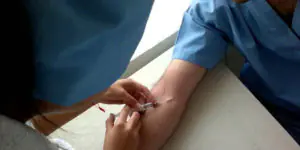Ethylene glycol poisoning can be acute or chronic. It occurs as a result of ingestion of this substance or when it comes into contact with the skin and respiratory tract. Until the early 2000s, ethylene glycol was actively used to adulterate alcoholic beverages.
For the first time, Soviet doctors had to deal with ethylene glycol intoxication during the Second World War. At that time, it began to be used as a brake fluid for armored vehicles and a de-icing agent in military aviation. The toxicity of ethylene glycol was noted during the First World War, when this liquid (instead of glycerin) was used to make dynamite.
The content of the articleGeneral information
Ethylene glycol is a dihydric alcohol. In its pure form it is a transparent liquid, colorless and odorless. This alcohol tastes slightly sweet and has an oily consistency. The substance is poisonous and belongs to hazard class III.
One of the ethers of ethylene glycol is propylene glycol. It is widely used in industry for the manufacture of polyester resins, medicines, antifreeze, brake fluid, and also as a food additive, as a solvent (E1520). Propylene glycol is also poisonous in large quantities. Poisoning with this substance develops hemolysis, hearing loss, liver and kidney damage.
The effect of ethylene glycol on the human body
After entering the human body, ethylene glycol is quickly absorbed from the stomach and intestines, like any alcohol, and enters the liver through the bloodstream, where it begins to decompose under the influence of alcohol dehydrogenase (ADH) into several toxic substances: oxalic acid, oxaloacetic acid and glyoxal. It is the oxidation products of ethylene glycol that pose a danger to humans.
The most dangerous decomposition product is oxalic acid, which in high concentrations disrupts the acid-base balance and prevents the excretion of calcium from the body. This leads to disruption of the transmission of neuromuscular impulses, inhibition of the central nervous system, and difficulty breathing. Oxalic acid binds to calcium and forms oxalate stones in the kidneys, which leads to the development of kidney stones and necrosis of the renal glomeruli and tubules.
Symptoms of acute ethylene glycol poisoning
When ingesting a concentrated solution or large volumes of ethylene glycol, clinical signs develop quite quickly, varying depending on the stage of intoxication:
- The period of intoxication. It manifests itself in a picture that is similar to ordinary alcohol intoxication. The degree of euphoria depends on the dose of alcohol taken: there are cases where people died after taking only 50 ml of poison, but survived after drinking 500 ml. The generally accepted lethal dose of ethylene glycol for humans is 100-150 ml of a 25-60% solution.
- A period of imaginary prosperity. It begins a few hours (usually 2-10 hours) after taking the poison. The well-being of the poisoned person is not affected. In most cases, the person simply falls asleep.
- Period of intoxication. At this stage, patients note the following symptoms:
- General weakness, dizziness, headache. This is a sign of damage to brain structures.
- Nausea, vomiting, and stomach pain indicate damage to the gastrointestinal tract.
- Low back pain occurs and quickly intensifies due to the destruction of the renal parenchyma.
- Subsequently, stupor develops, turning into a coma after 1-2 days. Breathing becomes deep and noisy. In the absence of consciousness, severe back pain, or clonic convulsions, providing first aid can be dangerous for the victim. In such cases, you should immediately call an ambulance team.
Treatment
All patients with suspicion are admitted to the intensive care unit (in large cities - to the toxicology department). The following therapeutic and diagnostic procedures are performed in hospital conditions:
- Hemodialysis is the most effective measure that removes all toxic substances from the body.
- Monitoring the acid-base balance of the blood. If it is violated, Hemodez is administered intravenously or Regidron is administered orally.

- A 5% solution of ethyl alcohol in a 5% glucose solution is administered intravenously along with 0.5 ml of magnesium sulfate for 2-3 days.
- For severe lower back pain, a perirenal block is used, which not only relieves pain, but also improves intestinal motility, which accelerates the elimination of toxins.
Consequences of taking ethylene glycol
After intoxication with ethylene glycol, consequences often remain in the form of toxic nephropathy, encephalopathy, and toxic hepatitis. In approximately 30-40% of survivors, persistent damage to renal function leads to degree I-II disability, and the patient is on an artificial kidney all his life. In some cases, which is quite rare, the poisoning goes away without a trace.
Prevention and rehabilitation
A measure to prevent intoxication is educational work with the population about the harmfulness of ethylene glycol to humans. Clinical practice shows that about 80% of those poisoned believe that antifreeze and brake fluid consist of real ethyl alcohol, and drink them without much fear. Thus, most of the population does not even know whether ethylene glycol is poisonous or not.
Preventive measures also include compliance with industrial safety regulations when working with ethylene glycol and the use of personal protective equipment.
Rehabilitation of those poisoned with ethylene glycol is carried out in sanatorium-resort institutions specializing in the treatment of kidney and urinary tract diseases (Yangan-Tau, Sergievsky Mineral Waters, Krainka, Vityazevo).



